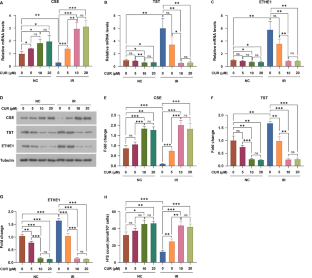Molecular Biology Reports ( IF 2.8 ) Pub Date : 2024-04-20 , DOI: 10.1007/s11033-024-09478-6 Jiankun Cui , Xin Wang , Lingling Dong , Qinwen Wang

|
Background
Our previous research shows that Curcumin (CUR) attenuates myocardial ischemia-reperfusion injury (MIRI) by reducing intracellular total RNA m6A levels. However, the mechanism remains unknown.
Methods
For ischemia-reperfusion (IR), H9c2 cells were cultured for 6 h in serum-free low-glycemic (1 g/L) medium and a gas environment without oxygen, and then cultured for 6 h in high-glycemic (4.5 g/L) medium supplemented with 10% FBS and a 21% oxygen environment. The effects of different concentrations of CUR (5, 10, and 20 µM) treatments on signaling molecules in conventionally cultured and IR-treated H9c2 cells were examined.
Results
CUR treatment significantly up-regulated the H2S levels, and the mRNA and protein expression of cystathionine γ-lyase (CSE), and down-regulated the mRNAs and proteins levels of thiosulfate sulfurtransferase (TST) and ethylmalonic encephalopathy 1 (ETHE1) in H9c2 cells conventionally cultured and subjected to IR. Exogenous H2S supply (NaHS and GYY4137) significantly reduced intracellular total RNA m6A levels, and the expression of RNA m6A “writers” METTL3 and METTL14, and increased the expression of RNA m6A “eraser” FTO in H9c2 cells conventionally cultured and subjected to IR. CSE knockdown counteracted the inhibitory effect of CUR treatment on ROS production, promotion on cell viability, and inhibition on apoptosis of H9c2 cells subjected to IR.
Conclusion
CUR attenuates MIRI by regulating the expression of H2S level-regulating enzymes and increasing the endogenous H2S levels. Increased H2S levels could regulate the m6A-related proteins expression and intracellular total RNA m6A levels.
中文翻译:

姜黄素通过增加内源性 H2S 水平并进一步调节 m6A 来减轻心肌缺血再灌注损伤
背景
我们之前的研究表明,姜黄素 (CUR) 通过降低细胞内总 RNA m 6 A 水平来减轻心肌缺血再灌注损伤 (MIRI)。然而,其机制仍不清楚。
方法
对于缺血再灌注(IR),H9c2细胞在无血清低血糖(1 g/L)培养基和无氧气体环境中培养6小时,然后在高血糖(4.5 g/L)培养基中培养6小时。 L) 培养基补充有10% FBS和21%氧气环境。检查了不同浓度的 CUR(5、10 和 20 µM)处理对传统培养和 IR 处理的 H9c2 细胞中信号分子的影响。
结果
CUR处理显着上调H 2 S水平以及胱硫醚γ-裂解酶(CSE)的mRNA和蛋白表达,并下调硫代硫酸盐转移酶(TST)和乙基丙二酸脑病1(ETHE1)的mRNA和蛋白水平。 H9c2 细胞按常规培养并进行 IR。外源 H 2 S 供应(NaHS 和 GYY4137)显着降低 H9c2 中细胞内总 RNA m 6 A 水平以及 RNA m 6 A“写入器”METTL3 和 METTL14的表达,并增加 H9c2 中 RNA m 6 A“擦除器”FTO的表达细胞按常规培养并进行红外检测。 CSE 敲低抵消了 CUR 处理对 ROS 产生的抑制作用、对细胞活力的促进作用以及对经受 IR 的 H9c2 细胞凋亡的抑制作用。
结论
CUR 通过调节 H 2 S 水平调节酶的表达并增加内源性 H 2 S 水平来减弱 MIRI。 H 2 S水平升高可以调节m 6 A相关蛋白的表达和细胞内总RNA m 6 A水平。



























 京公网安备 11010802027423号
京公网安备 11010802027423号